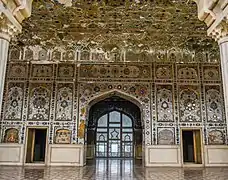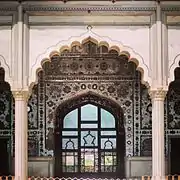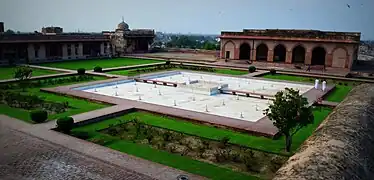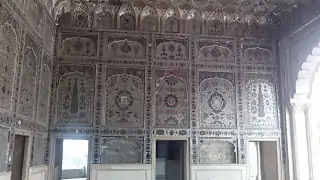Sheesh Mahal (Lahore Fort)
The Sheesh Mahal (Urdu: شیش محل; "The Palace of Mirrors") is a palace located within the Shah Burj block in northern-western corner of Lahore Fort. It was constructed under the reign of Mughal Emperor Shah Jahan in 1631–32, with some additions later under Sikh Maharaja Ranjit Singh. The ornate white marble pavilion is inlaid with pietra dura and complex mirror-work of the finest quality. The hall was reserved for personal use by the imperial family and close aides. It is among the 21 monuments that were built by successive Mughal emperors inside Lahore Fort, and forms the "jewel in the Fort’s crown."[1] As part of the larger Lahore Fort Complex, it has been inscribed as a UNESCO World Heritage Site since 1981.
| Sheesh Mahal | |
|---|---|
شیش محل | |
 | |
| General information | |
| Type | Public monument |
| Architectural style | Mughal |
| Location | Lahore, Punjab
Pakistan |
| Coordinates | 31°35′23″N 74°18′47″E |
| Construction started | 1631 |
| Completed | 1632 |
| Design and construction | |
| Architect(s) | Asif Khan |
Etymology

Sheesh Mahal, in Urdu language, literally means 'Crystal Palace'. However, with its pietra dura decorations[2] and intricate mirror-work inlaid into the white marble walls and ceilings creating gleaming effect,[3] the lavish room has come to be known as 'Palace of Mirrors', and sometimes the 'Hall of Mirrors'. Similar halls are also found in the contemporary palace of the Agra Fort, and show influence on the later additions to Amber Fort.
History

The solid brick foundations of Lahore Fort were laid in 1566 under the reign of Mughal emperor Akbar the Great on the location of an earlier mud-fort. To build the new fort, the Emperor brought experienced artisans after the completion of Fatehpur Sikri.[4] Later, Shah Jahan converted the fort into a pleasure resort and added Diwan-i-Khas, Moti Masjid, Naulakha Pavilion, sleeping chambers, and Sheesh Mahal in to the complex. Sheesh Mahal is located within the Shah Burj (King's Pavilion) block that was actually built by his predecessor Jahangir. The chamber was exclusively used for private council meetings as part of the daily routine of the emperor, whereas the whole block was only accessible to the imperial princes, the vizier, and selected courtiers.[5] The extension work of private quarters by Shah Jahan continued between 1628 and 1634. The distinctive Shah Jahani architecture is reflected in the extensive use of white marble and hierarchical accents of the construction.[6] During the Sikh Empire, Shah Burj became Ranjit Singh's favourite place. He built a harem over the top of Sheesh Mahal.[4] Kangra style frescoes were also added during his reign, and the original entrance to the Sheesh Mahal quadrangle was closed off and the Athdara built in its place. This was also the place where he used to display his prized possession, the Koh-i-Noor.[7]
Design


The Sheesh Mahal was built by Emperor Shah Jahan. It was built in the middle of Jahangir's rule. The façade, consisting of five cusped marble arches supported by coupled columns, opens into the courtyard. The engrailed spandrels and bases are inlaid with precious stones. The pavilion is in the form of a semi-octagon, and consists of apartments roofed with gilded cupolas and intricately decorated with pietra dura and convex glass and mirror mosaic (ayina kari) with thousands of small mirrors. At night they light candles.[8] The decorative features also include stucco tracery (munabat kari) and carved marble screens in geometrical and tendril designs.[9] The roof of the central hall rises up to two storeys. The hall was originally decorated with fresco paintings that were later replaced with glass mosaic in different colours.[1]
Conservation
-_Lahore_Fort-_%2540ibneazhar_Sep_2016_(90).jpg.webp)
The additional constructions carried out during the subsequent Sikh and British rules of Punjab on the top of Sheesh Mahal added to the dead load that made the structure vulnerable to collapse. In 1904–05, the plaster from the ceiling of main veranda fell apart, exposing the decay of internal wooden beams and the corroding roof. At this stage, the building was listed by the department of archaeology of British India in 1927 and the repair work was carried out. Similar problems arose in 1960s and were resolved through minor repairs.[10] In 1975, Sheesh Mahal was listed as a protected monument under the Antiquities Act by Pakistan's Department of Archaeology whereas in 1981, as part of the larger Lahore Fort Complex, it became inscribed as a UNESCO World Heritage Site. It was not until 2006 that the problems of the ceiling were comprehensively resolved and the structure was restored.[11]
Gallery
.jpg.webp) A view of the Sheesh Mahal's façade
A view of the Sheesh Mahal's façade-_Lahore_Fort-_%2540ibneazhar_Sep_2016_(77).jpg.webp)
 Close-up of Sikh era Kangra murals
Close-up of Sikh era Kangra murals The pillars used in the buildings were decorated with floral motifs
The pillars used in the buildings were decorated with floral motifs
 Sheesh Mahal's ceilings
Sheesh Mahal's ceilings
 Interior panorama view.
Interior panorama view.
 Another Sikh era Kangra mural of Hindu deities
Another Sikh era Kangra mural of Hindu deities

.jpg.webp)
 Sheesh Mahal Garden
Sheesh Mahal Garden Inside Sheesh Mahal
Inside Sheesh Mahal
.JPG.webp) Sheesh Mahal – Lahore Fort
Sheesh Mahal – Lahore Fort
See also
Notes
- Khan, Shehar Bano (2004) Wither heritage? Dawn. 11 July. Retrieved 22 April 2008
- Haider (1978)
- Shish Mahal, Lahore. British Library. Asia, Pacific and Africa Collections. Retrieved 21 April 2008
- Chaudhry (1998)
- Koch (1997), p. 151
- Koch (1991), p. 114
- Lal (1876)
- Lahore Fort Complex: Shish Mahal Archived 14 December 2010 at the Wayback Machine. Retrieved 21 April 2008
- Dogar (1995)
- Khan (1997)
- Cultural week opens at Fort. Dawn. 16 August 2006. Retrieved 22 April 2008
References
- Asher, Catherine E G (1992) Architecture of Mughal India. Cambridge University Press. ISBN 0-521-26728-5
- Chaudhry, Nazir Ahmed (1998) Lahore: Glimpses of a Glorious Heritage. Sang-e-Meel Publications. ISBN 969-35-0944-7
- Dogar, Muhammad Aasim (1995) Splendour of Lahore Fort. Ilm Dost Publishers.
- Haider, Zulqarnain (1978) Pietra Dura Decorations of Naulakha at Lahore Fort. (Mujallah-e-Taḥqĭq, Kullīyah-e-ʻUlūm-e-Islāmiyah va Adabiyāt-e-Sharqiyah). Faculty of Islamic and Oriental Learning University of the Punjab.
- Khan, Ahmed Nabi (1997) Studies in Islamic Archaeology of Pakistan. Sang-e-Meel Publications
- Koch, Ebba (1991). Mughal Architecture: An Outline of Its History and Development, 1526–1858. Prestel. ISBN 3-7913-1070-4
- Koch, Ebba (1997) Mughal Palace Gardens from Babur to Shah Jahan (1526-1648). Muqarnas, Vol. 14, pp. 143–165. JSTOR 1523242
- Lal, Kanhaiya (1876). Rai Bahadur. Zafar Nzmah-i-Ranjit Singh, Ranjit Namah. Mustafaee Press. Lahore
